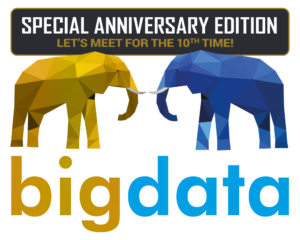 Online Webinars
Online Webinars
and WIN a ticket for
Big Data Tech 2024!

 Online Webinars
Online Webinars
and WIN a ticket for
Big Data Tech 2024!
Live Webinar,
14th March, 2024
21st March, 2024
15.00-16.30
Webinar starts in:

Big Data Technology Warsaw Summit is around the corner, but before we meet in Warsaw, we are happy to invite you for free online webinars!
Don’t miss the exclusive opportunity to expand your knowledge, discover cutting-edge insights, and engage with industry experts from Fandom, GetInData | Part of Xebia, Onehouse.ai, and more during our two events on March 14th and March 21st. Delve into data, analytics, ML, and cloud technologies, gaining invaluable expertise to stay ahead in the tech world.
Whether you are a data engineer, an ML specialist, or a technology enthusiast, our sessions will provide you with the necessary knowledge and tools to leverage the latest innovations in your work.
That is not all, during these webinars, you'll have the chance to enter a competition to win an invitation to the#BDTWS2024!
Register once to secure your attendance at both events and elevate your knowledge in the tech field!
What You Will Learn
>
01
>
02
>
03
How to build intelligent QA chatbots
How to optimize the DataOps processes
About Data Lakehouse architecture
>01
How to build intelligent QA chatbots
>02
How to optimize the DataOps processes
>03
About Data Lakehouse architecture
Agenda
We’ll demonstrate how to build an intelligent QA (Question-Answering) chatbot with RAG (Retrieval Augmented Generation) using your data as a knowledge base for question-answering. We’ll guide you through the whole process - from designing the architecture of the solution, through describing all the key components - including Document Embeddings, Vector DB and LLMs (Large Language Model) - and how to make them work together well.
We will show you key implementation code highlights, list required tools & frameworks and guide you through implementation process as well.
In this webinar you will learn how to leverage state of the art LLMs to build question answering system on your own data:
- you will understand necessary theory behind building RAG (Retrieval Augmented Generation) based systems
- after the webinar, you will know how to build similar system in your own organization
- you get access to fully working project boilerplate to built upon
By streamlining data workflows, improving data quality, and boosting business value, DataOps focuses on the complete data lifecycle – from data sources to transformation, analytics development, and delivery to business users. DataOps in practice means putting a couple of pieces together, experimenting and continuously improving the user experience of extracting value out of data. Snowflake and dbt have been in our workshops on various projects a number of times, join us to hear what we’ve learnt on how to make the most out of these two inspiring technologies!
In this webinar you will learn how to:
- implement DataOps strategies using dbt & Snowflake
- simplify orchestration of data pipelines with Snowflake Dynamic Tables for efficient data processing
- integrate materialized data tests in dbt with Snowflake Dynamic Tables for enhanced data quality assurance
- implement a data lakehouse blueprint with Snowflake’s Iceberg integration
Pain points are frequently encountered when aiming to orchestrate dbt (Core or Cloud) in a self-serve manner in a Data Mesh architecture. As part of this webinar we will examine a number of methods of orchestrating dbt including:
- YML files that create Airflow DAGs.
- Terraforming dbt Cloud jobs.
- YML files that create dbt Cloud jobs via the dbt Cloud API.
These options offer a number of advantages:
- When these YML files live in the dbt repo, dbt developers can orchestrate their project from within the project itself, this keeps orchestration as close to the code as possible and allows dbt project changes to be rolled out immediately.
- As the file is YML, and dbt already uses YML, dbt developers are not forced to learn a new programming language. Hence they are comfortable updating their orchestration settings without any dependency on engineering teams.
- Terraform is already a widely used Infrastructure-as-Code (IaC) tool, adding dbt Cloud jobs to Terraform encourages developers to treat their jobs as infrastructure.
- In a Data Mesh setup, self-service and scalability are requirements. Any new dbt project can include the YML file or Terraform code and automatically get their dbt project orchestrated.
My hope is that by sharing my experiences I can inspire other data practitioners to democratise their dbt orchestration and make their organisations more data driven.
Data Warehouses (RDBMS-OLAP) have been foundational to democratizing data and enabling analytical use cases such as business intelligence and reporting for many years. However, RDBMS-OLAP systems present some well-known challenges. Cloud data lakes have addressed some of the shortcomings of RDBMS-OLAP systems, but they present their own set of challenges. More recently, organizations have often followed a two-tier architectural approach to take advantage of both these platforms, leveraging both cloud data lakes and RDBMS-OLAP systems. However, this approach brings additional challenges, complexities, and overhead. This session will present how a data lakehouse, a new architectural approach, achieves the same benefits of an RDBMS-OLAP and cloud data lake combined, while also providing additional advantages. Through this session, the idea would be to break down the architecture of a data lakehouse & draw a comparison to the traditional data warehouse. We will focus on the following aspects:
- defining a standard terminology for data warehouse - breaking down/categorizing DWH into 3 parts:
- technical components - storage, compute, table/file format, etc.
- technical capabilities - concurrency, latency, ad hoc queries, etc.
- tech-independent practices - modeling, ETL, MDM, SCD, etc.
- show how a lakehouse satisfies these 3 components & the additional value that it brings
In this webinar you will get:
- Technical deep-dive of the Lakehouse architecture
- Comparison of the technical components, capabilities and technology-independent practices of data warehouses & lakehouses to prove that they are similar
- Additional benefits of a lakehouse architecture
- How to get started with architecting lakehouses
Check out the recordings of the Big Data Tech webinar experts!
To get access to the recordings, just complete the application form - you will receive a link to the recordings to your email address
Registration
"*" indicates required fields









